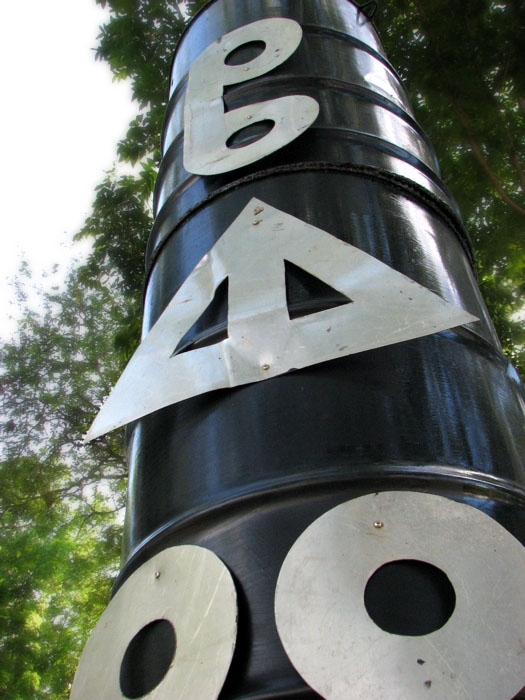
ke mi gadu | mi masa | mi bigi na ini a ulotu | fu a papila di yu be gi afaka...
It's estimated there are 25,000 to 30,000 speakers of Djuka (or Ndyuka), one of the Maroon languages of Suriname and French Guiana. Derived from English and several West African languages, Djuka has three distinct spoken dialects as well as a written form, called Afaka script after its creator.
Afaka Atumisi was a Djuka from the Tapanahony region of south-eastern Suriname. Circa 1910 -- inspired, he said, by a dream or vision -- he invented a syllabary of 56 characters which allowed Djuka texts to be recorded and transmitted in writing. Afaka died in 1918, but by 1920 it was reported that over a hundred people in the Tapanahony area could read and write his script.
Detail of one of Marcel Pinas's Kibi Wi totems, made from oil drums decorated with aluminium Afaka characters; Fort Zeelandia, Paramaribo, April 2009. Photo by Nicholas Laughlin
In later decades, the number of fluent readers and writers declined -- an article in the Suriname Museum journal in 1975 estimated that "most probably there remain only five." But more recently Afaka script, like other elements of Maroon culture, has been increasingly adopted (and adapted) as a symbol of Surinamese national identity, and the script is not an unfamiliar sight in Paramaribo. Afaka characters are a recurring and assertive motif in the work of Marcel Pinas, a member of the Djuka community in Moengo, but Surinamese artists from other ethnic backgrounds -- including Roddney Tjon Poen Gie and Sri Irodikromo -- also use the script in their exploration of the country's ethnic intricacies.
Air Borne (acrylic on canvas, 67 x 100 cm, 2009), by Roddney Tjon Poen Gie; photo by William Tsang, courtesy Readytex Art Gallery.
"Tjon Poen Gie is well known for using his own visual language, which is based upon the letter symbols of his ancestors," says the Readytex Gallery website." He draws the characters and symbols three-dimensionally and thus produces a playful abstraction of Chinese letters and Afro Surinamese Afaka symbols in his artwork."
The document reproduced at the top of this post is one of the earliest surviving texts written in Afaka script -- a letter by Afaka Atumisi which reports on his unsuccessful trip to the hospital in Paramaribo in search of treatment. Read a full translation here.
Document: Afaka's first letter
Wednesday, September 9, 2009
at 4:22 PM
Labels: afaka, document, irodikromo, language, pinas, tjon poen gie
Subscribe to:
Post Comments (Atom)






0 comments:
Post a Comment